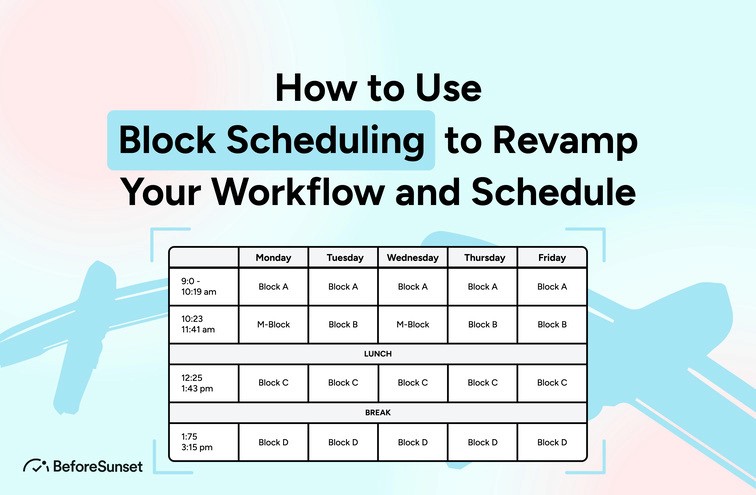Block scheduling is one strategy that is gaining popularity due to its potential to alter work routines and academic timetables. Individuals may structure their days into different blocks of concentrated work time by using block scheduling, which enables in-depth learning, greater attention, and less stress.
This blog will discuss how to utilize block scheduling to redesign your workflow and schedule, whether you're a student trying to improve your study habits or a professional looking to increase job efficiency.
We will examine the advantages, methods, and useful advice for effectively putting this ground-breaking time management methodology into practice, enabling you to accomplish your objectives and make the most of your time.

What Does Block Scheduling Work Best For?
Block scheduling may be most effective in certain school environments and with particular teaching philosophies. It has been used in a number of educational institutions and has proven to be more successful in the following situations:
In-Depth Learning: Block scheduling permits longer class sessions, which can be advantageous for disciplines that need in-depth study and investigation. The extra time for hands-on activities and creative projects is beneficial for subjects like scientific laboratories, the arts, music, and project-based learning.
Advanced Placement (AP) Courses: AP courses are frequently more demanding and need for in-depth study of challenging topics. These courses can go more in-depth with the material, have more discussions, and provide lengthier tests or projects because to block scheduling.
Student-Centered Learning: Block scheduling enables teachers to use a variety of instructional tactics, including active learning, group discussions, and project-based learning. It gives them more time to actively interact with the content, work with peers, and go deeper into the subject matter.
Reducing Student Stress: Students may feel less stressed because of a smaller daily burden if they have fewer lessons to concentrate on each day. They may have more time to comprehend information and finish duties as a result.
Flexibility in Course Offerings: Block scheduling can provide schools the flexibility to offer a greater selection of electives and courses. Longer class times provide teachers more time to cover a wide range of topics and fit in specialist courses that might not work well with conventional scheduling.
Teacher Collaboration: Collaboration among teachers: Longer class durations may provide for more time for planning and longer teacher collaboration. In order to establish multidisciplinary projects, coordinate curriculum, and exchange best practices, teachers can collaborate.
Is Block Scheduling Good or Bad?
Depending on the educational setting and the efficiency of execution, block scheduling can be both beneficial and detrimental. Block scheduling's lengthier class times promote deeper understanding, flexible teaching methods, and fewer transitions, which is advantageous for disciplines that call for prolonged involvement and practical activities.
It gives teachers the chance to implement engaging, group-based learning activities. A lighter daily burden and more opportunities to study optional courses may also help students feel less stressed.
Block scheduling has have many drawbacks, too, including the inability to change courses often, potential attention span problems, and restricted daily contact with teachers. Planning and teacher preparation are essential when switching to block scheduling.
Block scheduling's effectiveness ultimately depends on matching it with the school's objectives, taking into account student needs, and offering instructors and students the right kind of assistance.
Benefits of Using Block Scheduling
Block scheduling, a unique method of setting up the school day, is becoming more and more popular in educational settings due to its ability to completely transform the teaching and learning process.
Block scheduling, in contrast to the conventional timetable, uses longer teaching blocks, which generally last between 60 and 90 minutes. Parents, teachers, and students have all taken notice of this change in time allocation due to its numerous benefits.
We will examine the many advantages of block scheduling in this part, from promoting in-depth learning and creativity to lowering student anxiety and improving teacher cooperation. We can better comprehend how this scheduling method enhances the educational environment to foster academic achievement and overall growth by exploring its benefits.
1. Increased productivity
Block scheduling has a number of noteworthy advantages, one of which is the potential for improved student and instructor productivity. Since there is more uninterrupted time for concentrated learning and teaching during the extended class hours, teachers may go deeper into the subject matter and cover more material in a single lesson.
In-depth conversations, meaningful activities, and the examination of complicated subjects are all made possible by the longer time allotted for learning. Longer blocks of time help students to focus more intently on the subject matter since they have plenty of time to learn the content, engage in group activities, and carry out practical experiments.
Students can better keep their concentration and remain actively engaged in the learning process with fewer transitions between classes. This may result in better information retention and a more thorough comprehension of the material.
Block scheduling might further provide pupils the chance to improve their time management skills. They may spend more time on homework and studying because they have fewer classes to attend each day, which improves their preparation and time management abilities. This can lead to improved academic achievement and a feeling of success, which can increase the learning process.
Block scheduling makes planning and preparation for instructors more effective. Less courses to teach each day allows them more time to develop creative lesson plans, work with colleagues, and employ a variety of teaching techniques. As a result, teaching may become more meaningful and fulfilling, promoting personal and professional development.
2. Improved concentration and focus
The use of block scheduling in educational contexts has several important advantages, including increased focus and concentration. Students may focus more intently on the subject matter during the lengthier class hours since there are less disruptions from the frequent changes in classrooms.
This extra time gives pupils the chance to learn continuously and intently, which can improve their concentration and help them understand difficult subjects.
Longer blocks provide students more time to engage in deep conversations, practical exercises, and problem-solving activities. Critical thinking abilities are stimulated and active engagement is encouraged during this immersive learning experience. Students are able to focus better on the content at hand and have a deeper knowledge of the concepts being taught as a consequence.
Additionally, block scheduling can lessen the cognitive strain on students by reducing the number of classes they have each day, enabling them to devote more mental energy to the subjects they are learning. Less time spent mentally changing gears during class transitions enables students to maintain a more continuous and concentrated learning mentality throughout the day.
Furthermore, not just students can benefit from increased attention and concentration. Longer class durations are advantageous for teachers as well since they may go deeper into their courses and hold students' attention for longer. The extra time gives teachers the freedom to use a variety of teaching techniques, such as interactive discussions and hands-on activities, to create a stimulating learning environment that keeps students interested and on task.
3. Increased efficiency
By maximizing the use of time and resources, block scheduling can promote efficiency in educational environments. Longer class durations allow teachers to go into greater depth and cover more information, minimizing the need for repeated instruction over several days.
With this simplified method, teachers may use several teaching techniques including in-depth discussions and project-based learning to help students develop a deeper grasp of the subject. Less interruptions and transitions between sessions also benefit students, who can concentrate and engage more fully during longer learning blocks.
Concentration and information retention are improved since moving between subjects is less taxing on the brain. Additionally, educators have more time for professional development and cooperation, which results in coherent curricula and shared best practices.
Overall, block scheduling encourages a more productive and efficient learning environment, which is advantageous to both teachers and students.
4. Reduced stress and pressure
Block scheduling in educational settings has the ability to significantly benefit both students and instructors by lowering stress and strain. Students face a lower daily workload since class durations are extended and there are fewer subjects to concentrate on each day. This lessens the hustle and stress brought on by having to finish several tasks and prepare for numerous exams in a short amount of time.
Longer class durations provide students more opportunity to understand material and participate in worthwhile activities without feeling pressured. Because there are fewer transfers between classes, kids have more time to organize their time well and experience less stress at school.
Teachers are also benefiting from the decreased stress. Longer class periods enable more effective planning and preparation, giving instructors more time to create compelling courses and thoroughly evaluate student progress. For educators, this may lead to a more evenly distributed workload, which will improve their wellbeing and job satisfaction.
Block scheduling can also encourage a more laid-back learning environment since it gives students the chance to really engage with the topic and contribute to conversations. This can promote effective learning by reducing the pressure on students to memorize material for quick tests and increasing their attention to really comprehending the material.
5. Increased ability to multi-task
Block scheduling may improve pupils' capacity for efficient multitasking. Longer class times give students the chance to participate in more comprehensive and in-depth learning activities, some of which may require multitasking. They may devote more time to difficult tasks, talks, or assignments, which forces them to effectively manage their time, resources, and attention.
Students learn important skills in teamwork, communication, and time management when they engage in projects or group activities for lengthy periods of time in class. They gain the ability to successfully prioritize tasks, strike a balance between competing demands, and collaborate with colleagues. These abilities may be used outside of the classroom and be helpful in a variety of real-life scenarios where multitasking is frequently necessary.
In addition, block scheduling may enable students to devote more time and mental energy to certain projects, enhancing their capacity for concentration and enabling them to move between various tasks more fluidly. This may help them manage different duties in other aspects of their lives, such as extracurricular activities or part-time work, by enabling them to multitask effectively.

How Do You Adjust to Having This Much Control Over Your Schedule?
Know the Benefits: Become familiar with the benefits of block scheduling, such as boosted productivity, lowered stress levels, and enhanced focus. Understanding the advantages might inspire you to make the change.
Plan Ahead: Make a timetable in advance to make the most of the extended class periods. Make a daily or weekly calendar. For each block, establish specific objectives and assign tasks a priority.
Use Your Time Wisely: Make the most of the extra time during class by concentrating on in-depth study and fun activities. To make the most of the opportunity to study fully, stay focused during class.
Accept Flexibility: Block scheduling may provide you greater freedom in deciding when to finish particular activities or projects. Accept this flexibility and choose the optimum moment for you to address particular difficulties.
Maintain Organization: By maintaining organization, you can keep up with your obligations and duties. To properly manage your time and keep track of deadlines, use planners, calendars, or digital tools.
Seek Support: If you're having trouble adjusting to block scheduling, ask your teachers, your friends, or educational resources for help. They can offer advice and assist you in maximizing your schedule.
Reflect and Adapt: Regularly evaluate your block scheduling experiences and make necessary modifications. Determine what is effective and what requires improvement, and modify your strategy appropriately.
How to Implement Block Scheduling in Your Workflow
Identifying your goals and important activities is the first step in integrating block scheduling into your workflow. Allocate certain activities or categories to each block of time as you divide your workday into several halves.
You may, for instance, designate a block for creative work, another for administrative duties, and a third for conferences or other forms of communication. Depending on your tastes and the difficulty of the activities involved, decide on the optimal length for each block.
The order of these blocks should be laid out in a daily or weekly timetable, with enough time allotted for each task. Avoid distractions and multitasking by concentrating entirely on the assigned work throughout each block of time. Utilize block scheduling's flexibility to modify and improve your strategy as you learn what boosts your productivity and efficiency the most.
Make any required tweaks and improve your process as you go to achieve the best results. Regularly assess your progress.
Tips and Tricks for Effective Block Scheduling
Time management and productivity may both be considerably improved by effective block scheduling. To maximize the effectiveness of this scheduling strategy, consider the following advice
Establish Specific Objectives: Specify your short- and long-term objectives to order tasks within each block. You can maintain concentration and utilize your time more effectively if you have a strong sense of purpose.
Make a Daily Schedule: Make a detailed plan for your day, including a list of the exact things you'll focus on in each block. Be honest about the amount of time needed for each work and schedule rest periods in between blocks.
Prioritize Important Tasks: Place high-priority and difficult jobs in the blocks when you're attentive and focused. Prioritize Important jobs. This makes sure that important task gets your full attention.
Similar Tasks Together: Batch related tasks into a single block. By reducing context switching and increasing efficiency, this method enables you to finish connected activities faster.
Reduce Distractions: At the beginning of each block, put your phone on silent mode, disable alerts, and create a distraction-free workspace.
Take Breaks: Block scheduling promotes concentrated work, but it's important to incorporate brief rest periods in between blocks so that you can refuel. Stretching or taking brief walks might help you stay energized and focused all day.
Stay Flexible: Maintain your flexibility and embrace block scheduling. Be prepared to modify your timetable if a block takes longer than anticipated or if a task becomes more important.
Evaluate and Modify: Consistently examine your block schedule to determine its efficacy. Determine trends, advantages, and potential improvement areas. If necessary, change your schedule to maximize productivity and balance.
Establish Boundaries: If working in a team, let your teammates know about your block schedule. Establish rules for working together while taking breaks, and encourage respect for each other's concentrated work time.
Be Realistic: Be realistic and refrain from packing your calendar with too many things or blocks of time. Give yourself wiggle room and flexibility to deal with unforeseen circumstances or difficulties.

Block Scheduling: Potential Challenges and Solutions
While block scheduling has many benefits, there may also be some possible drawbacks. Longer class times may cause students' attention spans to lengthen, which might affect how engaged they are.
Teachers may solve this by incorporating engaging activities and a variety of instructional strategies to keep students engaged. Due to fewer lessons per day, interacting with professors on a regular basis is a difficulty as well.
To guarantee continued assistance and advice, schools might set up frequent communication channels, virtual office hours, or check-ins. It might be difficult to pace lessons and cover the entire curriculum, so thorough lesson planning and formative evaluations are essential. Schools may also run into scheduling issues or need to make changes to accommodate longer times.
To come up with workable ideas, teachers, administrators, and students must work together. Breaks in between blocks, which provide students time for exercise or relaxation, can be used to maintain attention and fight student tiredness. Schools may successfully use block scheduling while promoting the best possible learning environment by tackling these difficulties head-on with proactive tactics.
Block Scheduling Tools and Resources
Block scheduling has become a well-liked strategy in educational settings because it provides longer class hours and better opportunity for in-depth study and concentrated work. Teachers, students, and administrators can use a variety of useful tools and resources to successfully adopt block scheduling and maximize its advantages.
The process of developing and monitoring block schedules is streamlined by these tools, which also help with scheduling, time management, and organizing. These tools enable educational institutions to increase productivity, cooperation, and general efficiency.
They range from online calendars and task management applications to project management systems. In this section, we'll look at a variety of block scheduling tools and resources that might help educational institutions adopt this ground-breaking scheduling approach.
1. BeforeSunset AI
BeforeSunset is the perfect solution for busy professionals and teams who want to create a block scheduling system. With BeforeSunset, you can quickly and easily create a customized schedule with just a click using AI. This makes it easier to manage your time and improve your productivity.
BeforeSunset also helps you to stay organized and focused, ensuring that you can make the most of your time and get the most out of your day. With BeforeSunset, you can streamline your workflow and make sure that you get the most out of your time and resources.
2. Google Calendar:
Block scheduling in educational settings may be implemented using Google Calendar, which is a flexible and user-friendly application. Teachers may designate events for each block period using this digital calendar platform, and they can adjust the start and finish hours to fit the duration of their sessions.
Different blocks can be easily differentiated visually by color coding and labeling. Teachers may manage their time effectively and stay organized by setting reminders and recurring events. The sharing function in Google Calendar enables easy contact with students, parents, and coworkers while ensuring that everyone is informed of the block schedule.
Google Calendar enables educational institutions to maximize time management, collaboration, and productivity while establishing an effective and focused learning environment, whether viewed on desktop or mobile devices.
3. Microsoft Outlook:
Block scheduling in educational contexts may be implemented using a powerful platform provided by Microsoft Outlook. Educators may designate events for each block period using the calendar function, selecting start and finish timings as well as customizing colors for simple identification.
Regular classes are streamlined by recurring appointments, and each block's assignments and to-do lists are organized with the use of task management tools. Outlook's sharing features enable easy contact with students and coworkers, boosting cooperation and coordination.
Reminders and alarms guarantee timeliness and readiness for each session. Integration with other Microsoft Office programs enables the connecting of pertinent documents and resources to certain block events. Microsoft Outlook is a helpful tool for maximizing time management, improving communication, and increasing productivity in educational institutions through block scheduling.
Its user-friendly design and mobile accessibility through the Outlook app make it possible.

